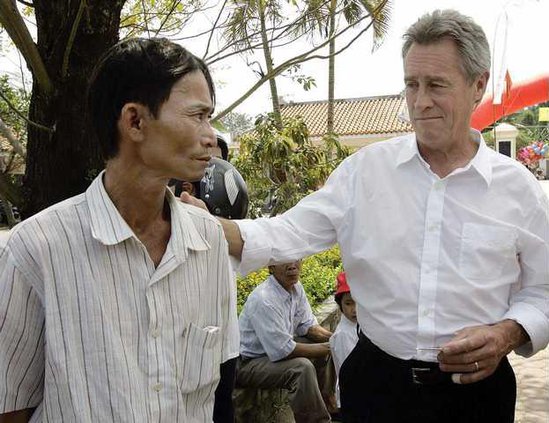MY LAI, Vietnam - Lawrence Colburn returned to My Lai on Saturday and found hope at the site of one of the most notorious chapters of the Vietnam War.
On the 40th anniversary of the massacre of up to 500 unarmed Vietnamese villagers, the former helicopter gunner was reunited with a young man he rescued from rampaging U.S. soldiers.
On March 16, 1968, Colburn found 8-year-old Do Ba clinging to his mother's corpse in a ditch full of blood and the bodies of more than 100 people who had been mowed down. Nearly all the victims were unarmed women, children and elderly.
"Today I see Do Ba with a wife and a baby," said Colburn, a member of a three-man Army helicopter crew that landed in the midst of the massacre and intervened to stop the killing. "He's transformed himself from being a broken, lonely man. Now he's complete. He's a perfect example of the human spirit, of the will to survive."
Colburn, 58, now runs a medical supplies business north of Atlanta. He, Ba and hundreds of others are gathering this weekend to remember the My Lai massacre, a grim milestone that shocked Americans and undermined support for the war, which ended in 1975 with the fall of Saigon to communist troops.
Buddhist monks in saffron robes led the mourners in prayer Saturday outside a museum that has been erected to remember the dead. An official memorial program will be held on Sunday.
Among those coming to pray was Ha Thi Quy, 83, a My Lai survivor who suffers from anger and depression four decades after the slaughter. Soldiers from the Army's Charlie Company shot her in the leg and killed her mother, her 16-year-old daughter and her 6-year-old son.
Her husband later died of injuries from the massacre and another son had to have an arm and a leg amputated after suffering gunshot wounds that day.
Quy only survived because she was shielded beneath a pile of dead bodies.
"The American government should stop waging wars like they waged in Vietnam," Quy said. "My children were innocent, but those American soldiers killed them."
Seymour Hersh, the journalist who exposed the massacre, said he sees parallels between My Lai and a more recent story that he has he reported on, the 2005 images of torture from the Abu Ghraib prison in Iraq. But he says the public furor unleashed by My Lai was far greater.
"It's stunning how much impact My Lai had and how little impact Abu Ghraib had," Hersh said by telephone from Washington. "We'll have to leave it to historians to figure out why."
On that morning 40 years ago, Colburn flew over My Lai on a reconnaissance mission with pilot Hugh Thompson and crew chief Glenn Andreotta. After several runs over the area, they realized that unarmed civilians were being slaughtered by U.S. troops on the ground.
The members of Charlie Company were a "search and destroy" mission, trying to track down elusive Vietcong guerrillas, whose tactics had depleted the company's ranks.
The company's soldiers began shooting in My Lai that day even though they hadn't come under attack. It quickly escalated into an orgy of killing.
Thompson landed the helicopter between the villagers and the marauding troops. While Colburn and Andreotta covered him, Thompson persuaded the members of Charlie Company to stop shooting.
The angry and frustrated troops had found themselves in a bewildering war where it was impossible to distinguish friend from foe, said Stanley Karnow, an American historian who wrote "Vietnam: A History."
Their actions shocked the American public, who had preferred to think of U.S. troops as heroes making the world safe for democracy, Karnow said.
Colburn and Andreotta, who died later in the war, found Do Ba after the shooting stopped.
"He was still clinging to his mother," Colburn said.
Ba's aunt raised him in My Lai. When he turned 18, he moved to the former Saigon, now known as Ho Chi Minh City, where he is married with a 14-month-old daughter and works at an electronics factory.
He and Colburn were first reunited at the 2001 dedication of a new school in the village. At that time, Ba was single, haunted by memories of My Lai and eager to start a family.
So much has changed since the day they first met, Ba said. The United States and Vietnam, former enemies, have become allies and developed a booming trade relationship.
"I'm glad the United States and Vietnam have become friends," Ba said. "But I still feel hatred for the soldiers who killed my mother, my brother and my sister."

